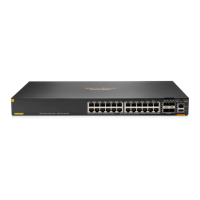316
Task Command
Display BGP VPNv6 peer information.
display
bgp
[
instance
instance-name ]
peer
vpnv6
[ ipv4-address mask-length | { ipv4-address |
group-name
group-name }
log-info
| [ ipv4-address ]
verbose
]
Display BGP VPNv6 routes.
display bgp
[
instance
instance-name ]
routing-table vpnv6
[ [
route-distinguisher
route-distinguisher ] [ ipv6-address
prefix-length [
advertise-info
] |
as-path-acl
as-path-acl-number |
community-list
{ { basic-community-list-number |
comm-list-name } [
whole-match
] | adv-community-list-number } ]
|
peer
ipv4-address {
advertised-routes
|
received-routes
}
[ ipv6-address prefix-length |
statistics
] |
statistics
]
Display incoming labels for all BGP
VPNv6 routes.
display bgp
[
instance
instance-name ]
routing-table vpnv6
inlabel
Display outgoing labels for all BGP
VPNv6 routes.
display bgp
[
instance
instance-name ]
routing-table vpnv6
outlabel
Display BGP VPNv6 address family
update group information.
display bgp
[
instance
instance-name ]
update-group vpnv6
[ ipv4-address ]
Display OSPFv3 sham link information.
display ospfv3
[ process-id ] [
area
area-id ]
sham-link
[
verbose
]
For more information about the display ipv6 routing-table, display bgp group vpnv6, display
bgp peer vpnv6, and display bgp update-group vpnv6 commands, see Layer 3—IP Routing
Command Reference.
111B
IPv6 MPLS L3VPN configuration examples
274BConfiguring IPv6 MPLS L3VPNs
531BNetwork requirements
CE 1 and CE 3 belong to VPN 1. CE 2 and CE 4 belong to VPN 2.
VPN 1 uses route target attributes 111:1. VPN 2 uses route target attributes 222:2. Users of different
VPNs cannot access each other.
Run EBGP between CE and PE switches to exchange VPN routing information.
PEs use OSPF to communicate with each other and use MP-IBGP to exchange VPN routing
information.

